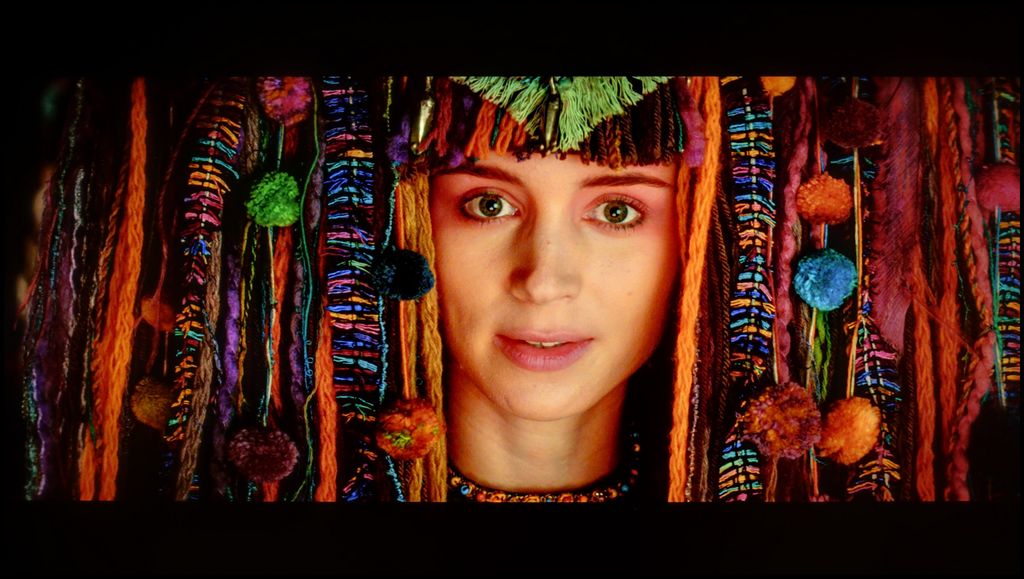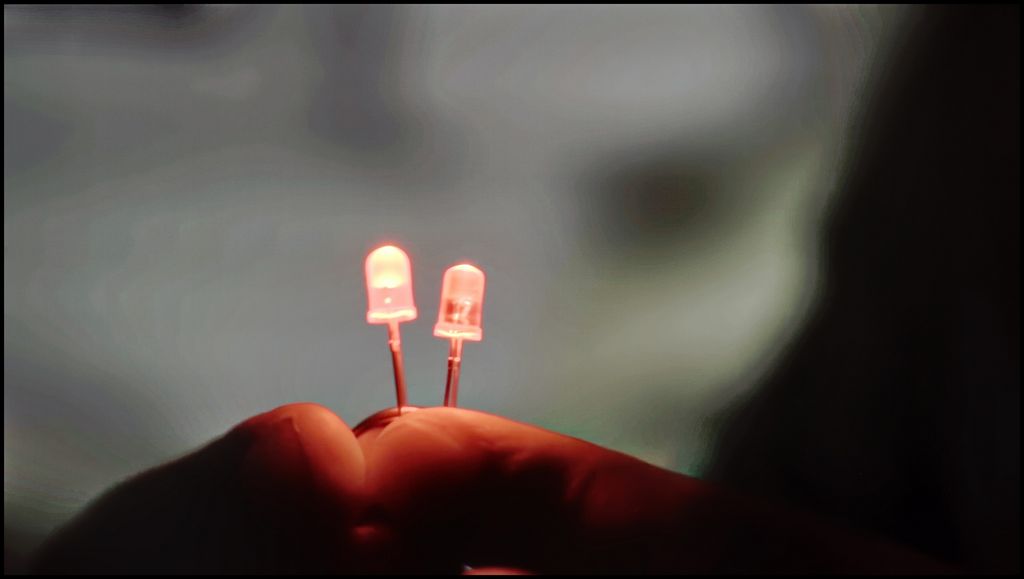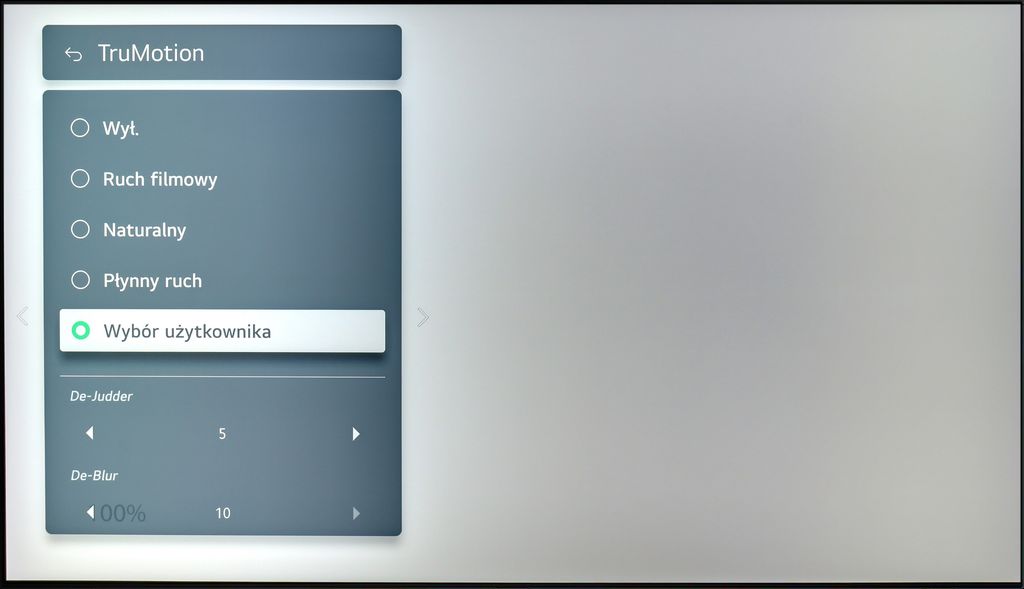- Matching (Score)
- Our verdict
- Competing TVs
- TV appearance
- Where to buy
- Contrast and black detail
- HDR effect quality
- Factory color reproduction
- Color reproduction after calibration
- Smoothness of tonal transitions
- Image scaling and smoothness of tonal transitions
- Blur and motion smoothness
- Console compatibility and gaming features
- Input lag
- Compatibility with PC
- Viewing angles
- Daytime performance
- TV features
- Apps
- Playing files from USB
- Sound
- Panel details
LG 55 B4 Review
B46 / B42 / B43
Available screen sizes:

Complete the survey to find out the result
Panel type: WRGB OLED Refresh rate: 120Hz Brand: LG Resolution: 3840x2160 System: WebOS Model year: 2024
LG B4 - Our verdict
8.1
Overall rating
The LG OLED B4 is an exceptionally versatile television within the semi-premium category. Given its impressive features and competitive pricing—set to drop further as history suggests—it offers outstanding value. The hypnotic combination of perfect black levels and high contrast will captivate anyone familiar with OLED technology, making a return to LCD screens almost unthinkable. While its peak brightness in HDR content might seem modest on paper, the visual experience is enhanced by the panel’s inherent strengths, making the brightness appear far more impactful. It’s also worth highlighting the stability and uniformity of brightness across most scenes. The slight drawback is the reduced brightness in full-frame white scenes, though these are relatively rare and thus not a major concern.
Factory colour reproduction is commendable, offering a good baseline that benefits significantly from calibration, fully realising the director’s vision. The LG B4 is particularly well-suited for gamers and sports enthusiasts alike. Gamers will appreciate the comprehensive HDMI 2.1 support and associated features, while sports fans will enjoy the advanced motion smoothing with its extensive adjustment options. The remote control, equipped with a gyroscope, allows for intuitive navigation akin to using a mouse, making the experience even more seamless.
The WebOS system is another highlight, offering a smooth, responsive interface with a vast array of applications, meeting the needs of most users. At the core of the LG B4 is its advanced Alpha processor, responsible for enhancing image smoothness and conducting detailed signal analysis. The processor’s ability to optimise the darkest and brightest areas of the image significantly improves the viewing and gaming experience. Furthermore, it effectively reduces noise and elevates the overall content quality, especially when viewing 4K material, placing the LG B4 ahead of many competitors in its price bracket.
The growing popularity of OLED technology is well-reflected in the LG B4, which excels in handling dynamic action scenes, offering seamless transitions without blurring. This makes it particularly appealing to discerning users prioritising high image quality and cutting-edge technology. All essential applications are present, ensuring a comprehensive user experience.
In summary, who is the LG OLED B4 for? It’s the perfect choice for those seeking top-tier image quality within a set budget, yet it offers more than just value for money. The LG B4 stands out distinctly in its price range, offering superior image quality that many competitors cannot match.
Advantages
Reference color reproduction after calibration
Very good image compliance with the director's intentions
Excellent cooperation with consoles and PCs
Advanced motion smoothing system
Deep and vivid image
Extensive WebOs system and "mouse" remote control
Disadvantages
Visible tonal transitions
Movies and series in UHD quality
8.1
Classic TV, YouTube
8.8
Sports broadcasts (TV and apps)
8.6
Gaming on console
9.3
TV as a computer monitor
7.6
Watching in bright light
5.7
Utility functions
8.9
Apps
9.1
Sound quality
7.1
Complete the survey to find out what fits your preferences
LG B4 - Competing TVs in this price range
LG B4 - TV appearance
HDMI inputs: 0 x HDMI 2.0, 4 x HDMI 2.1 (48Gbps) Outputs: Toslink (Optical audio), eARC (HDMI), ARC (HDMI) Network Interfaces: Wi-Fi 2.4GHz, Wi-Fi 5GHz, Ethernet (LAN) 100Mbps
Build quality: Good
Stand type: Legs
Bezel color: Black







Stand: Fixed
Flat design: No
Accessories: Stand
Buy at the best price
Select size:
LG B4 - Contrast and black detail
10/10

Result
∞:1

Result
∞:1

Result
∞:1

Result
∞:1

Result
∞:1
Visibility of details in the lights:

The LG B4 employs OLED panels produced by LG Displays, offering perfect contrast and true black levels. This results in an image so vivid and dynamic that it can appear almost three-dimensional. The "B" series has consistently been an ideal choice for those seeking excellent image quality without the premium price tag associated with higher-tier models. Thanks to competitive pricing, the B series often rivals Mini LED televisions, frequently emerging victorious. Unlike LCD TVs with local dimming, the LG B4 avoids common issues like blooming, halo effects, or dimming of fine bright details.
This superiority is particularly evident in challenging test scenes, such as those from Oblivion and Sicario 2. The LG B4 handles these with impressive finesse, delivering a high level of visual depth. In Oblivion, the bright lights are distinctly separated, maintaining clarity and precision without blending into each other. Similarly, in The Sicario 2, scenes featuring heli highlight the B4's ability to render intricate details and preserve the film’s unique colour grading, even in darker, more demanding moments. This exceptional performance in both contrast and detail demonstrates the LG B4’s capability to bring cinematic experiences to life.
Halo effect and black detail visibility:
LG B4 - HDR effect quality
6.3/10
Supported formats: HDR10, Dolby Vision, HLG Color gamut coverage: DCI P3: 99.0%, Bt.2020: 75.0%
Luminance measurements in HDR:

Result
664 nit

Result
650 nit

Result
677 nit

Result
662 nit

Result
410 nit
The HDR brightness performance of the LG B4 is impressive, even though it doesn't surpass 1000 nits. Its luminance stability is consistently strong across various scenarios, delivering a reliable viewing experience. The only instance where the TV shows slight weakness is in scenes with large areas of bright white, which has long been a challenge for OLED technology. However, perfect contrast, deep blacks, and excellent brightness ensure a fully immersive HDR experience. Furthermore, the TV’s remarkable 99% coverage of the DCI-P3 colour gamut enhances its colour vibrancy, making images appear rich and visually striking. This level of colour accuracy and brightness balance firmly places the LG B4 among the top choices for HDR content.
Scene from the movie “Pan” (about 2800 nits)

Scene from the movie “Billy Lynn” (about 1100 nits)

Let’s examine two challenging test scenes from The Master and Billy Lynn. The first scene, mastered to exceptionally high brightness, performed admirably. While the TV cannot achieve the same luminance levels, the image is only slightly dimmed, with highlight and cloud details preserved at an impressive level, thanks to the well-implemented dynamic tone mapping feature. The second test scene, with its diverse contrast and vibrant fireworks display, was handled superbly by the LG B4, faithfully capturing the director's vision. Additionally, skin tones appeared remarkably natural, with a rich range of shades that added a heightened sense of realism.
HDR luminance chart:
HDR luminance
Luminance of RGB colors
As demonstrated, the tone mapping function performs exceptionally well in films. However, we tested it further in a more challenging scenario involving an image with a significant amount of white. Thanks to the effective dynamic tone mapping (DTM) feature, details remain highly visible, with only minor elements blending slightly into the background. Therefore, we strongly recommend enabling this feature. The LG B4 also supports HDR Dolby Vision, which utilises dynamic metadata to adjust the image frame by frame. When a Dolby Vision signal is provided, previously subtle details become vividly clear. This highlights the importance of this format for TVs that don’t exceed the 1,000-nit brightness threshold.
Static HDR10

Dynamic: Dolby Vision

Factory color reproduction
8.4/10
The best factory preset offered by LG B4 is the "Filmmaker" mode, which we used throughout our testing. Straight out of the box, the TV delivered fairly accurate colour reproduction. However, the most significant issue in both SDR and HDR content was the white balance. In SDR, there was a noticeable red dominance, giving the image a distinct yellow tint, particularly evident in skin tones and whites. In HDR, this red hue persisted, but the lack of blue also introduced a greenish tint in certain scenes. Additionally, we observed some inconsistencies in grayscale and colour accuracy. Despite these shortcomings, the overall picture quality was still solid for most viewing scenarios.
Color reproduction after calibration
9.3/10
LG B4 has long been known for offering advanced calibration tools, and it remains one of the few manufacturers that allows such in-depth image adjustments. Thanks to these tools, we calibrated the device to an exceptional standard. The result was incredibly low deltaE errors, considered at a reference level. Both SDR and HDR content now display exactly as the filmmaker intended. This level of precision is one of the reasons LG TVs are frequently used as preview monitors in graphic design and post-production studios.


LG B4 - Smoothness of tonal transitions
7.4/10
The smoothness of tonal transitions, often overlooked in tests of competing platforms, is a crucial aspect of image quality, especially when watching content with a rich colour palette and complex effects, where textures overlap. This can sometimes result in colour banding or a lack of smooth gradation. The LG B4 performs quite well in terms of smoothing these tonal transitions. However, it has weaker moments, such as bright coloured skies in films like Kingsman and The Martian. Despite these minor issues, they do not significantly detract from the viewing experience. Therefore, we positively assess the quality of tonal transitions in the LG B4.








Image scaling and smoothness of tonal transitions
7.9/10
Smooth transition function

Image without overscan on the SD signal

In this section, we will revisit the smooth transition function while also examining how the TV handles lower-quality content. As we’ve found, the setting responsible for smooth gradation is generally effective, though it does have its drawbacks. While the function works well in SDR content, it becomes less useful in HDR content. Even at the lowest setting, it can blur important details, so we advise against using it in such cases.
The image scaling on the LG B4 is assessed moderately positively. While there is no noticeable edge doubling, the image tends to be somewhat "soft." This can be adjusted by tweaking the sharpness slider to improve the clarity.
LG B4 - Blur and motion smoothness
8.5/10
Maximum refresh rate of the panel: 120Hz
Film motion smoothing option: Yes
Blur reduction option: Yes
BFI function 60Hz: Yes, 60Hz (image flickers)
BFI function 120Hz: Yes, 120Hz
Brightness drop with BFI: 49%

The maximum refresh rate on the LG B4 is 120 Hz, the bare minimum for those requiring high image fluidity. The manufacturer has equipped the TV with a multi-stage motion smoother called "TruMotion." This feature is split into two sliders: one controls the sharpness of moving images (De-Blur) and the other adjusts judder (De-Judder). Both sliders can be set between 0 and 10, with each level affecting the smoothness, so users can easily find their preferred setting.
The LG OLED B4 panel boasts an impressive average response time of 0.1 ms (based on our measurements), delivering an exceptionally clear image that surpasses the capabilities of LCD TVs, which often have response times of several milliseconds. This is particularly noticeable in the "UFO Test" images, where no trailing blur is visible behind moving objects.
Blur (native resolution, maximum refresh rate):



Blur (BFI function enabled):



An additional feature designed to enhance image fluidity on the LG B4 is "OLED Motion," which uses black frame insertion (BFI) between film frames to "reset" the retina and improve image sharpness. However, this feature proves to be ineffective, as enabling it causes the television to drop every second frame, which severely impacts viewing comfort and leads to a noticeable reduction in smoothness.
LG B4 - Console compatibility and gaming features
10/10
ALLM: Yes
VRR: Yes
VRR range: 40 - 120Hz
Dolby Vision Game Mode: Yes
Correct implementation of HGIG: Yes
1080p@120Hz: Yes
1440p@120Hz: Yes
4K@120Hz: Yes
Game bar: Yes


The LG B4 has four full HDMI 2.1 ports, each providing 48Gbps bandwidth. This ensures smooth activation of all relevant features without issues, making the television highly suitable for gaming. With its low input lag and extensive functionality, including well-implemented HGIG mode and Dolby Vision gaming with low latency, the B4 is a strong contender for gamers who demand high quality.
A standout feature is GameBar, which allows for on-the-fly adjustments without interrupting gameplay, as well as image adaptations for those with visual impairments. Another key point is that when VRR technology is enabled, the television maintains its contrast, thanks to the OLED panel's structure, though slight flickering in grey shades is to be expected.
In conclusion, the LG B4 is an ideal choice for gamers, seamlessly combining high performance with excellent gaming features. Its 120Hz panel and HDMI 2.1 ports make it a standout option for those seeking top-tier gaming experiences.



LG B4 - Input lag
10/10
The LG B4 boasts incredibly low latency across all scenarios. Even the most dedicated gamers will appreciate the exceptionally low input lag, which remains at just 5 ms, even during demanding 4K 120 Hz settings with HDR. Notably, latencies are unchanged when Dolby Vision HDR is enabled, a feature that is not always guaranteed by competitors. This consistent performance deserves the highest praise and a strong recommendation.
| SDR | HDR | Dolby Vision |
|---|---|---|
| 1080p60: 13 ms | 2160p60: 13 ms | 2160p60 DV: 13 ms |
| 1080p120: 5 ms | 2160p120: 5 ms | 2160p120 DV: 5 ms |
| 2160p60: 13 ms | ||
| 2160p120: 5 ms |

LG B4 - Compatibility with PC
7.6/10
Chroma 444 (maximum resolution and refresh rate): Yes
Font clarity: Good
Readability of dark text and shapes: Very Good
Input lag in PC mode (4K, maximum refresh rate): 5ms
Matrix subpixel arrangement: RWBG
Max refresh rate: 120Hz
G-Sync: Yes
The LG B4 performs excellently when paired with a PC, thanks to its incredibly low latency of just 13.5 ms, providing near-instantaneous response between the mouse, eye, and screen. Text readability is very good on this television, with sharp fonts achievable by enabling the passthrough option in the settings. The RWBG pixel arrangement has no significant impact on font or letter display, offering a clear advantage over Samsung’s QD-OLED panels. Users of both Windows and macOS-equipped computers will appreciate the solid performance of the LG B4 screen.
LG B4 - Viewing angles
7.4/10
Brightness drop at an angle of 45 degrees: 29%
One of the undeniable advantages of OLED panels, including the LG B4, is their excellent performance during group viewing, maintaining good contrast, colour saturation, and fidelity from different angles. While it doesn’t benefit from MLA technology like other OLED models, the overall performance remains impressive, and owners are unlikely to be dissatisfied. However, it’s worth noting that at sharp angles, a slight greenish tint can be observed. This is a characteristic of WRGB panels from LG that lack micro-lens technology, and unfortunately, this issue cannot be mitigated.
LG B4 - Daytime performance
5.7/10


Panel finish: Satin
Reflection suppression: Decent
Black levels during daytime: Very Good
The maximum brightness of the LG B4 in SDR content reaches 370 nits, which is a commendable result for an OLED television, providing comfortable viewing even in well-lit environments. However, there are two important considerations. First, the television's ability to manage reflections is somewhat average, primarily due to the satin finish of the panel. This means that direct light hitting the screen may cause noticeable reflections. Secondly, the screen's brightness when displaying 100% white fill is around 260 nits. This is a noteworthy improvement, as OLED televisions in this price range previously achieved only half that brightness. This enhancement makes the LG B4 well-suited for watching high-brightness content, such as winter sports.
Panel brightness
Average luminance SDR
LG 55 B4: 374 cd/m2
LG B4 - TV features
8.9/10
System: WebOS
System performance: Good
- HDMI inputs: 0 x HDMI 2.0, 4 x HDMI 2.1 48Gbps
- Outputs: Toslink (Optical audio), eARC (HDMI), ARC (HDMI)
- Network Interfaces: Wi-Fi 2.4GHz, Wi-Fi 5GHz, Ethernet (LAN) 100Mbps
- TV reception: DVB-T, DVB-T2, DVB-S, DVB-S2, DVB-C
Classic features:
Recording to USB (terrestrial TV): Yes
Recording programming: Yes
Picture in Picture (PiP): No
RF remote control (no need to aim at the screen): RF
Backlit remote control: No
Teletext: Yes
Audio only mode: Yes
Bluetooth headphones support: Yes
Simultaneous Bluetooth headphones & TV audio: Yes
Smart features:
AirPlay: Yes
Screen mirroring (Windows Miracast): Yes
Voice search: Yes
Voice search in native language: Yes
Ability to connect a keyboard and mouse: Yes




The LG B4 uses the well-established WebOS system, a staple in LG's smart TVs for many years. This system offers a wide range of essential applications, with only a few notable omissions, such as CDA and KODI. One of WebOS's standout features is its cursor functionality, which activates when the remote control is moved, making it especially convenient for entering search queries or passwords on websites.
In addition, WebOS supports various features such as screen mirroring, AirPlay, voice search in Polish, and Bluetooth headphone connectivity. An added bonus is the ability to use the television’s speakers and headphones simultaneously, which is particularly beneficial for individuals with hearing impairments. For sports enthusiasts, the system also includes alerts for upcoming matches, ensuring you never miss a broadcast.
The home panel in WebOS is another strength, offering seamless control of all smart devices connected to the home network. For example, users receive notifications when a laundry cycle is completed, enhancing the overall convenience of the system.
In conclusion, while WebOS may have some limitations compared to Android TV, it provides stable and fast performance, supporting most key functions users expect. It's a reliable and straightforward operating system for those looking for an easy-to-use interface for their television.
Sound connection options
HDMI audio:
Other audio outputs:
Toslink: Yes
Wireless audio:
Bluetooth: Yes
Supported audio formats (external HDMI eARC audio):
Dolby Digital Plus 7.1: Yes
Dolby True HD 7.1: Yes
Dolby Atmos in Dolby Digital Plus (JOC): Yes
Dolby Atmos in Dolby True HD: Yes
DTS:X in DTS-HD MA: Yes
DTS-HD Master Audio: Yes
Senior accessibility
Numeric keyboard on TV: Yes
Font size adjustment: No
Audio description: Yes
LG B4 - Apps
9.1/10























LG B4 - Playing files from USB
8.5/10

| Maximum photo resolution: | Supported photo formats: |
|---|---|
The default file player in the LG B4 performs well with most photo and video formats, supporting a wide range of popular codecs, including Dolby Vision. However, there are a few limitations that may disappoint some users. For example, the TV only supports two photo formats: JPEG and PNG, which could be a downside for those accustomed to the HEIC format used by Apple devices. Unfortunately, there is no native support for HEIC files, but the built-in AirPlay feature can serve as a workaround for Apple users. Additionally, while the TV can handle most video formats, it does not support the H.266 VVC codec, which is currently not widely used.
Another limitation is the lack of support for TXT subtitles, which may be an issue for users who rely on these for certain content. Despite these minor drawbacks, the LG B4 offers a solid file playback experience overall.
LG B4 - Sound
7.1/10
-
Maximum volume
Supported codecs
(TV speakers)
Dolby Digital Plus 7.1
Dolby True HD 7.1
Dolby Atmos in Dolby Digital Plus (JOC)
Dolby Atmos in Dolby True HD
DTS:X in DTS-HD MA
DTS-HD Master Audio
The audio system in the LG OLED B4 is quite decent and performs well within its price range. The bass is noticeable but does not overwhelm the other frequencies, resulting in a balanced sound overall. While the built-in speakers are adequate for casual viewing, it is likely that most users opting for a high-quality OLED display will already have an external audio system to enhance their experience. However, the inclusion of DTS-HD Master Audio and Dolby Atmos codecs adds value, offering more advanced audio support for those who connect external sound systems. This makes the B4 a solid choice for users prioritising image and sound quality.
Acoustic Measurements
No acoustic data
LG B4 - Panel details
Software version during testing: 03.11.10
Panel uniformity and thermal imaging:

Founder and originator of the "ChooseTV" portal

Journalist, reviewer, and columnist for the "ChooseTV" portal
See articles related to LG 55 B4:
9/10/2025
1/16/2025
1/16/2025
3/6/2025











